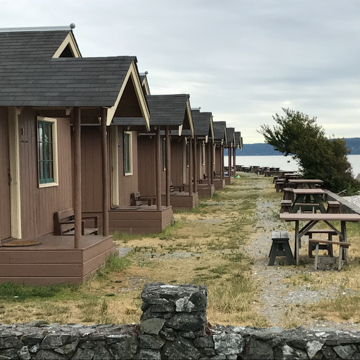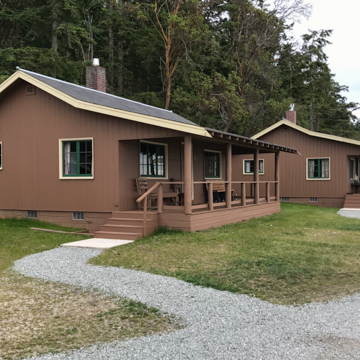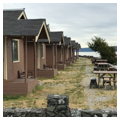You are here
Cama Beach Historical State Park
The Cama Beach Resort opened in 1934 as an automobile-oriented recreation resort approximately 65 miles north of downtown Seattle. The resort featured basic cabin accommodations with adjacent automobile parking along the sweep of a pebble beach on the western shore of Camano Island, facing the Saratoga Passage in the Puget Sound. Buildings primarily sit on the beach shelf, but a handful are located on the adjacent, tree-covered slope. Access to the resort was historically from a road along the ridge of the slope and down a lane following the topography to the beach. The site has limited landscaping, as most of the area was paved in gravel to accommodate parking and informal recreational activities. The site is believed to have been used as a fishing village by Native American tribes for at least 1,600 years prior to its transformation for recreational use.
The original construction of the Cama Beach Resort in the mid-1930s met a widespread cultural demand as automobile transportation and economic forces reshaped the nation. Hundreds—possibly thousands—of small, automobile-oriented camping sites and resorts from the 1920s through the 1940s catered to families traveling new highways with their private cars, which were becoming increasingly affordable to the middle class. These “auto camps” often featured tents and small cabins that allowed ready access to roads, parking, and nearby recreation. The auto camp at Cama Beach was one example of several such developments built around the Puget Sound, although it is the only auto camp in the region to maintain continuous operation after 1964.
Construction of the original resort buildings occurred between 1932 and 1934. The buildings included two dozen waterfront cabins (in two rows along the sweep of the beach), two “deluxe” cabins, a combined store and office building, a gasoline pump canopy, a recreation hall, a ping pong pen, and support structures (including a fire-truck garage). Additional structures were added through 1950, including a house for the owner (1941) and additional lodging and recreation spaces. The resort ultimately expanded to include ten “deluxe” cabins and a few slightly larger bungalows on the southern end of the complex. Although some structures were destroyed or removed after 1950 (and the complex underwent a significant rehabilitation process during its transformation to a state park in the early 2000s), Cama Beach Resort has remained largely unchanged.
Arguably the most striking aspect of the resort are the two rows of approximately 14 x 20–foot original one-story cabins, whose designs—with their two protruding gable roofs—vaguely resemble informal, one-story bungalows. Versions of these building types, originating in the Bengal region of India, had become popular as housing in the early-twentieth-century American West due to their informality, adaptability to mild climates, mass production, and relatively low cost.
As temporary cabins, however, the Cama Beach structures are far more stripped-down than the bungalow. The light wooden-frame buildings rest on stone pier foundations and feature little more on the facade than a window, a door, and steps leading to a basic veranda supported by two plain wooden columns and covered by one of the gable roofs. Inside, the cabins include divided sleeping quarters, an eating area, and a kitchenette with a stove, running water, and an ice cooler. The original, still-intact windows use a unique double-sliding pocket construction that permits, with a single motion, a glazed sash to be opened and replaced by an integral screened sash. With the exception of the boathouse, the buildings are constructed from cedar in a vernacular Craftsman style.
From the resort’s beginnings, boat rentals were central to visitor activities, so the original owner, LeRoy Stradley, included boat sheds along with the two rows of tourist cabins. He also added the “deluxe” cabins, two actual bungalows, a store, an owner’s house, and numerous support buildings. A new boathouse (1949–1950), following a similar design but using concrete masonry units, was built after a fire destroyed one of the original wooden boat sheds. (The remaining original boat sheds were repurposed and modified for recreational use and storage.) The Center for Wooden Boats now operates out of the boathouse. Stone signage and a concrete sea wall (to protect the buildings from water damage) was added in 1950.
Between 1934 and 1989, the resort was continuously operated by successive generations of a single family. In the 1990s, the resort was purchased by the state for public use and, along with 400 surrounding acres, was converted to a state park in 2008. Excavation in 2002, however, identified evidence of historic seasonal use, burials, and a large shell midden associated with the Tulalip, Swinomish, Upper Skagit, and Stillaguamish tribes. The park’s new facilities were redesigned to ensure protection of the midden and other archaeological sites.
To avoid disturbing archaeological sites, the interpretive center and ranger station, event center, site utilities, and access roads were relocated. The new buildings, which include a cafe and large social hall, are located on the hillside away from the original beach compound and were designed to mimic the character of the original 1932 cabins; they feature double gables, simple massing, and board-and-batten construction. Known as Cama Beach Historical State Park since 2008, the cabins remain available for rent.
References
Kapralos, Krista J. “Tulalips Continue Fight for Cama Beach.” The Herald(Everett, WA), January 10, 2008.
Lentz, Florence K., “Cama Beach Resort,” Island County, Washington. National Register of Historic Places Inventory–Nomination Form, 1999. National Park Service, U.S. Department of the Interior, Washington, D.C.
McAlister, Damon. “Placid Park Belies a Major Engineering Effort.” Seattle Daily Journal of Commerce, November 19, 2009.
Ochsner, Jeffrey Karl. “Past Present: Cama Beach Renewed.” Arcade30, no. 3 (2012).
Riddle, Margaret. “Cama Beach State Park on Camano Island Officially Opens on June 21, 2008.” Essay 8843. HistoryLink.org: The Free Online Encyclopedia of Washington State History. November 16, 2008. Accessed June 30, 2017. www.historylink.org.
Thompson, Lynn. “Newest State Park: Beach, Cabins, Conflict.” Seattle Times(Seattle, WA), June 12, 2008.
Writing Credits
If SAH Archipedia has been useful to you, please consider supporting it.
SAH Archipedia tells the story of the United States through its buildings, landscapes, and cities. This freely available resource empowers the public with authoritative knowledge that deepens their understanding and appreciation of the built environment. But the Society of Architectural Historians, which created SAH Archipedia with University of Virginia Press, needs your support to maintain the high-caliber research, writing, photography, cartography, editing, design, and programming that make SAH Archipedia a trusted online resource available to all who value the history of place, heritage tourism, and learning.




















